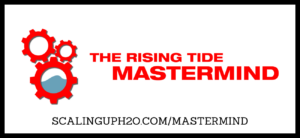 “Your test kit is your tool, and you are the master of that tool. “– Trace Blackmore
“Your test kit is your tool, and you are the master of that tool. “– Trace Blackmore
In this insightful episode of Scaling Up! H2O Podcast, host Trace Blackmore delves into the critical topic of understanding and optimizing water treatment tests. This episode is designed to equip water treatment professionals with practical knowledge to enhance their test-taking techniques and interpretation skills.
The Concept of Pinks and Blues
Trace shares the origins of the term “pinks and blues,” coined by his father, and explains its significance in water testing. He stresses the importance of understanding that tests are tools to confirm or disprove hypotheses about system conditions, not tasks that generate revenue. This foundational mindset shift sets the stage for improving both the efficiency and effectiveness of test execution.
Strategic Testing Approaches
Trace provides a comprehensive breakdown of running tests in the most efficient order, starting with the longest tests and multitasking with shorter ones while waiting. This strategic approach helps water professionals maximize time on-site. He also discusses the value of running tests based on hypothesis-driven objectives, such as walking through the site and engaging with clients before taking samples.
Categorizing and Interpreting Your Tests
Listeners will gain insight into organizing test types into meaningful categories:
- Base water
- Concentrated water
- Product contributions
- System signs
Trace illustrates how to establish true concentration levels and interpret results to identify potential issues like scaling, precipitation, and system corrosion. The importance of using non-scaling ions, like silica, for accurate concentration analysis is also explained.
Analyzing Interpretative Skills
Trace walks through examples that highlight how to use test results for informed decision-making, whether it’s confirming system status or taking corrective action. He advises on how to integrate polymer tests and other contributing product measurements into your routine for a fuller picture of system health. This deep dive into interpretation emphasizes a detective-like approach to problem-solving in water treatment.
Final Thoughts and Essential Tips
The episode concludes with Trace’s encouragement to prioritize understanding your test procedures and knowing the interferences that can affect results. He underscores the importance of planning tests efficiently and being prepared with all necessary tools before visiting client sites. By mastering these practices, listeners can transform their testing routine into a powerful tool for maintaining system integrity and customer relationships.
Stay engaged, keep learning, and continue scaling up your knowledge!
Timestamps
00:50 – Trace Blackmore explains what Pinks and Blues means sharing how his father influenced his understanding of water tests
02:09 – Upcoming Events for Water Treatment Professionals
05:34 – Explanation of “Pinks and Blues” and the importance of interpreting test results for water treatment.
43:21- Drop by Drop with James McDonald
Connect with Scaling UP! H2O
Submit a show idea: Submit a Show Idea
LinkedIn: in/traceblackmore/
YouTube: @ScalingUpH2O
Quotes
“The equipment knows, but it cannot talk. We’ve got to do all this investigation work to figure out what the equipment knows that won’t give up that information. We’ve got to figure out ways to make it talk now.”
Scaling UP! H2O Resources Mentioned
AWT (Association of Water Technologies)
The Rising Tide Mastermind
Scaling UP! H2O Academy video courses
Submit a Show Idea
Hach Water Analysis Handbook
046 The One About Phosphate Testing
Drop By Drop with James
In today’s episode, let’s picture in your mind a boiler that is open for inspection. As you stand in front of it, you may see the handholes and manholes opened. The room may be much quieter than normal because the burners and air blowers aren’t running. It may be a firetube or water tube boiler. The inspection will be different between the two, with several commonalities as well. Before you start your inspection, what should you do? Have you spoken to the operators in the area? Have you followed proper safety protocols for confined space entry, lockout/tagout, etc.? Do you feel safe entering the boiler? Do you know the history of the boiler before going in? Does this history of water treatment and boiler performance allow you to predict what you will see inside the boiler? How will you document what you find? How will you collect any samples, if necessary? How dirty will you get? Do you know the equipment you will see inside the boiler, such as steam-water separators, baffle plates, downcomers, feedwater piping, etc.? What do you expect the water line to look like? Where will oxygen pitting or hard water scaling first show up in the boiler if there was a problem? Will you be inspecting the deaerator as well? How long will it take you to get the boiler inspection report to your client? Doing a proper boiler inspection takes time, experience, knowledge, attention to detail, and often agility.
Events for Water Professionals
Check out our Scaling UP! H2O Events Calendar where we’ve listed every event Water Treaters should be aware of by clicking HERE.





